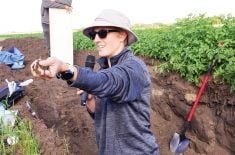Three American winter wheat growers earned extra cash this summer by winning their classes in the inaugural Kansas Wheat Yield Contest.
Central Kansas
Danee Helvey picked up a $1,000 US cheque for growing 94.36 bushels per acre.
A disciple of the intensive wheat management regimen popularized by Phil Needham, Helvey always starts with top-quality, certified seed that has been length graded, cleaned on a gravity table and tested for germination.
The seed was treated with Raxil plus Gaucho and planted at a rate of 250 seeds per sq. yard. Helvey put 11-52-0 in the row at planting and 28 percent sulfur applied at top dress time with streamer bars.
Read Also

Soybean market still figuring out implications of China-U.S. pact
Soybean futures had a muted reaction to the U.S. trade deal with China as the market tries to figure out the nuances of the deal.
A veteran no-tiller, Helvey fallowed the field before planting wheat. He applied fungicide and insecticide at flag leaf emergence and harvested the 157 acre field with a stripper header to preserve residue.
“Intensive management is expensive, but the larger yields pay off, Helvey said.
Western Kansas
Jon Buehler grew 93.31 bu. per acre on a 154-acre field of fallow ground.
He treated the seed with Gaucho XT and planted 60 pounds per acre with a hoe drill.
He applied ten tons of cattle manure before seeding, followed by 24 pounds of nitrogen in January and another 12 lb. of nitrogen later. In March he applied Rave herbicide and TwinLine fungicide.
“If we have a real good year and I don’t do much to help the crop, then it will be average,” Buehler said.
“But if I do all I can, it pays off in the end. It may be tough to show profit when wheat is $3, but now we’re close to $6. The better the price, the more those details pay off.”
Buehler uses a conservation tillage program that includes a couple of passes with an undercutter before planting.
Eastern Kansas
Alvin Schmedemann won with a yield of 52.40 bu. per acre on a certified organic crop.
His contest plot is creek bottom soil that had been fallowed in 2009.
Schmedemann used no fertilizer, seed treatment, fungicide or herbicides. He worked the ground with a plow, tandem disk and harrow to prepare the seedbed.
He planted 86 lb. of seed per acre with a Crustbuster hoe drill on 8.5 inch spacing.
“I planted Dominator because several years ago that variety yielded 80 bu. per acre. I was impressed and have been using it ever since,” Schmedemann said.















